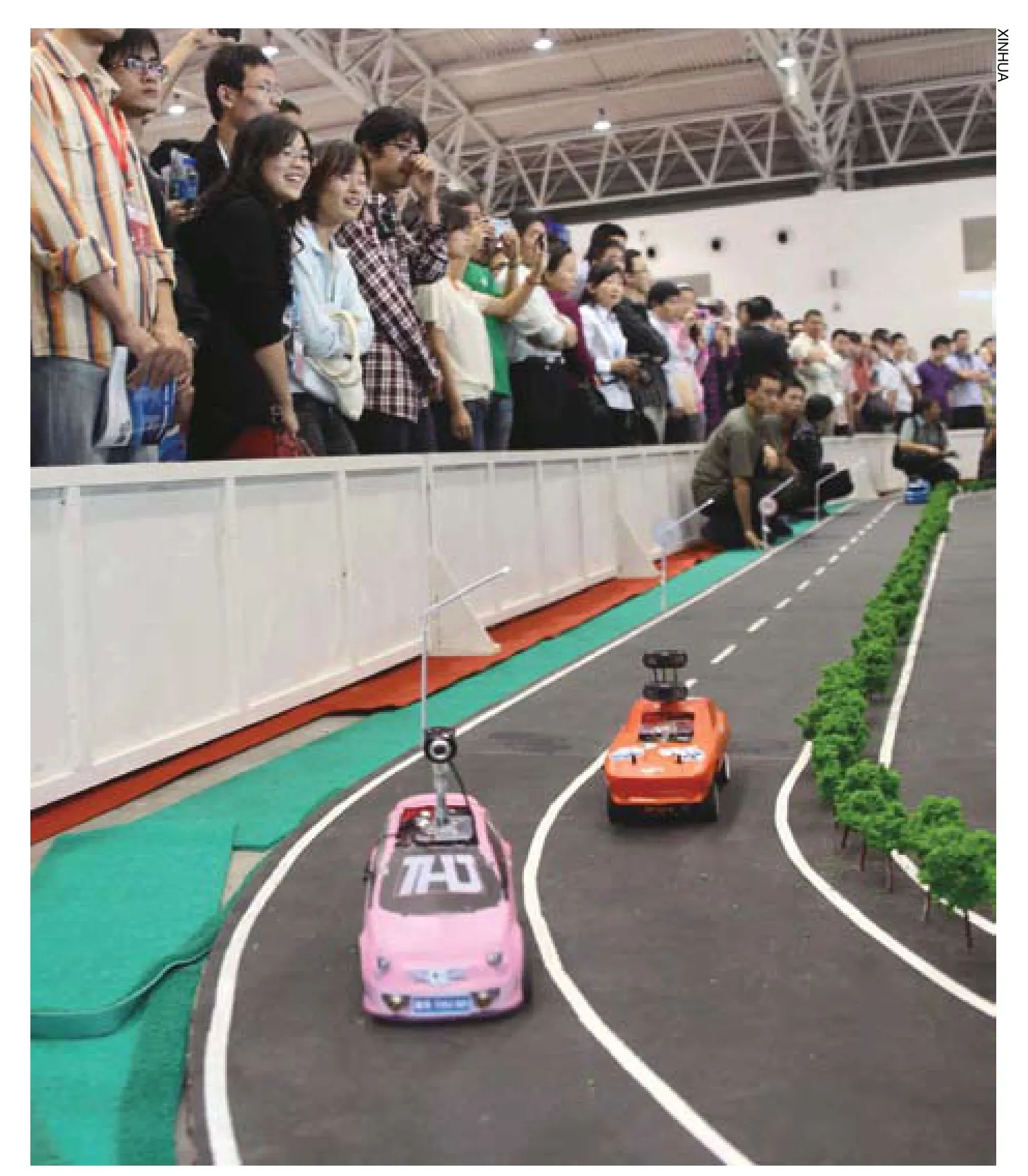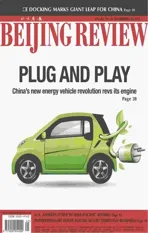Robots in Disguise
2011-10-14ByTANGYUANKAI
By TANG YUANKAI
Robots in Disguise
By TANG YUANKAI
China’s driverless intelligent automobile technology is now world class

SMALL BUT SMART: Miniature intelligent cars provide an eye opener for visitors to the China International Intelligent Industries Expo in Beijing on September 16
Driverless vehicles may seem like an outlandish concept to most people, more like something from the movieTransformersthan everyday reality. The reality in China, however, is that intelligent vehicles have now developed from a concept to a promising area of scientific research.
The intelligent automobile, also known as robotic or driverless, is an autonomous vehicle capable of fulfilling the transportation functions of a traditional car. A human may choose a destination, but is not required to operate the vehicle.
From October 20-21, the residents of Erdos in Inner Mongolia got a glimpse of the future when a number of driverless vehicles drove through the region as part of the China Intelligent Automobile Challenge. Teams from more than 10 universities and research institutes specialized in the research and development of intelligent automobiles, such as Wuhan University and Xi’an Jiaotong University participated in the event.
Hosted by the National Natural Science Foundation Commission of China (NSFC), this is the third installment of the annual competition. The previous two challenges were held in Xi’an, Shaanxi Province.
“This competition offers a platform for us to demonstrate the latest intelligent automobile technologies, turning research fruits from laboratories into real application,” said Zheng Nanning, an academician at the Chinese Academy of Engineering and President of Xi’an Jiaotong University.
The 2011 challenge marked the frst time the event was held under real road conditions. The intelligent vehicles were separated into groups of two and competed in seven tests which included identifying traffc signs, avoiding barriers and making a U-turn.
Driverless vehicles have been a dream for many scientists and science fction writers since the automobile was invented. Countries such as the United States and Germany began researching driverless technologies in the 1980s and China is now trying to catch up.
“China’s technologies in the feld remain underdeveloped, but with more investments and concerted research efforts, huge progress in unmanned vehicles is expected to be made by 2015 and it’s very likely that China will soon catch up with the world’s leaders in the feld,” said Zheng.
The goal was set already—by 2015, China should have the technologies for completely automatic unmanned vehicles, which can operate continuously for more than 200 km in a natural environment, and 2,000 km on the expressway.
Defining “smart”
Dubbed “Outdoor Mobile Robots,”driverless automobiles see and respond to the world like human beings. The cameras and sensors in the intelligent automobile are like its eyes while the computer is its brain. Information is collected by the “eyes” and integrated and dealt with by the “brain.”By processing information on the vehicle’s destination, weather conditions and the movement of other vehicles, the electronic“brain” can make quick decisions on the best route and speed.
Intelligent automobile technology integrates advanced technologies in fields such as cognitive science, computer science and artificial intelligence. Perception of the natural environment and intelligent decision making are two key technologies required for unmanned driving.
The National University of Defense Technology successfully ran its unmanned Hongqi HQ3 automobile for more than 286 km, setting a new record in the country on July 14, 2011.
“Human intervention is less than 1 per-cent of the total, a percentage smaller than the generally defined standard of 3 percent for autonomy, making China one of the countries with world class intelligent automobile technologies,” said Dai Bin, one of the scientists working on the experiment.
The experiment was sponsored by Hongqi Group, one of China’s major vehicle manufacturers, and the vehicle achieved an average speed of 87 km per hour. “We set a maximum speed of 110 km per hour, but everything else was automatic,” said Dai. “It stepped on the gas, put on the brakes, made turns and changed paths automatically.”
The vehicle overtook other cars on the road 67 times during the experiment. But it was safe because it was programed to step on the brakes the moment it is too close to another vehicle. “Generally the reaction time for machines can reach 40 milliseconds, much shorter than the time human beings need for quickest reaction—about 500 milliseconds,” said Dai.
Birth of Hongqi HQ3
The vehicle, Hongqi HQ3, made a sensation in its 2007 debut, because China developed the entire system for it.
“China won’t have a say in the field if we can’t develop our own unmanned automobiles,” said He Hangen, professor at the National University of Defense Technology and another member of the Hongqi HQ3 research team.
At an international seminar on unmanned driving He attended in 1996, Japanese experts turned down the request of Chinese researchers to join in a proposed multinational research project because China hadn’t yet developed its own unmanned vehicles. From then on, He and Dai have led the team to make a series of breakthroughs in key technologies and built from scratch China’s frst unmanned automobile in 2001.
Some overseas experts at that time agreed that 70 km per hour was the speed cap for unmanned automobiles because of a 200-millisecond delay in reaction of the unmanned control system, but China’s first driverless car could drive at a speed of 76 km per hour. He and his team solved the problem by integrating intelligent control solutions into an advanced cognitive analysis system, which made the “brain” of their vehicle capable of multi-task processing.
In 2003, the team set a world record when their vehicle reached a speed of 170 km per hour.
Now, while competing with international peers, Chinese experts on driverless technologies are sticking to a different way. Unlike foreign unmanned vehicles which rely on GPS information and digital mapping, China’s Hongqi HQ3 uses an environment sensing system and an intelligent decision making and control system.

ONE OF A KIND: The Hongqi brand driverless car demonstrates China’s latest unmanned driving technologies at the China National Convention Center from September 6 to 10
With breakthroughs in intelligent automobile technologies, vehicle manufacturers, software providers and telecom operators have all invested in a future when intelligent vehicles become affordable.
Currently, intelligent driving technologies are used to make driving a simpler task, enhance the safety of automobiles and reduce car accidents.
IT applications in vehicles, for instance, are bringing huge changes to the traditional automobile industry. A new model equipped with a “smart” navigation system, which is powered by WCDMA mobile network, is rolling off the assembly line of Shanghai Automotive Industry Corporation Group. And private automaker BYD has already introduced the S6 model featuring some intelligent functions, such as a digital security system, a voice electronic navigation system and a car reserving camera installed on the rear.
Red light still on
Scientists have to overcome a number of obstacles before anyone drives home a real intelligent car. Limited cognition capacity of the current generation computers could be the biggest one.
“Although intelligent vehicles are already powerful in collecting information, how to process a sea of information to make the right decisions is a hard nut to crack,”said Zhang Zhaotian, Deputy Director of the Department of Information Sciences under the NSFC. “Computers can process numbers well, but will be outperformed by kindergarten kids when the task is about cognition.”
Zhang gave the example of difficulties in distinguishing shadows from actual obstacles with cameras. “It could take too much time even if a right decision is fnally made,” he said.
Inconsistent and unstable performance of unmanned vehicles also accounts for a lack of confdence in such technologies from both manufacturers and customers. “Driverless technologies have to be improved to help intelligent vehicles adapt to complicated environments,” said He Kezhong, professor in the Department of Computer Science and Technology at Tsinghua University.
Reliability and safety are big issues for unmanned vehicles. But the camera in the sensing system, for example, can only work between 0 and 50 degree Celsius, hardly reliable in all circumstances. “New technologies and materials are badly needed in the feld. Until these problems are solved, automobile companies and customers won’t accept intelligent vehicles,” He Kezhong said.
A lack of communication and cooperation between research institutes and automobile companies is another problem. “It is impossible to work out standards for driverless technologies without participation of major auto companies,” said He. “But such technologies are crucial to the future competence of auto companies once they reach full maturity.”
